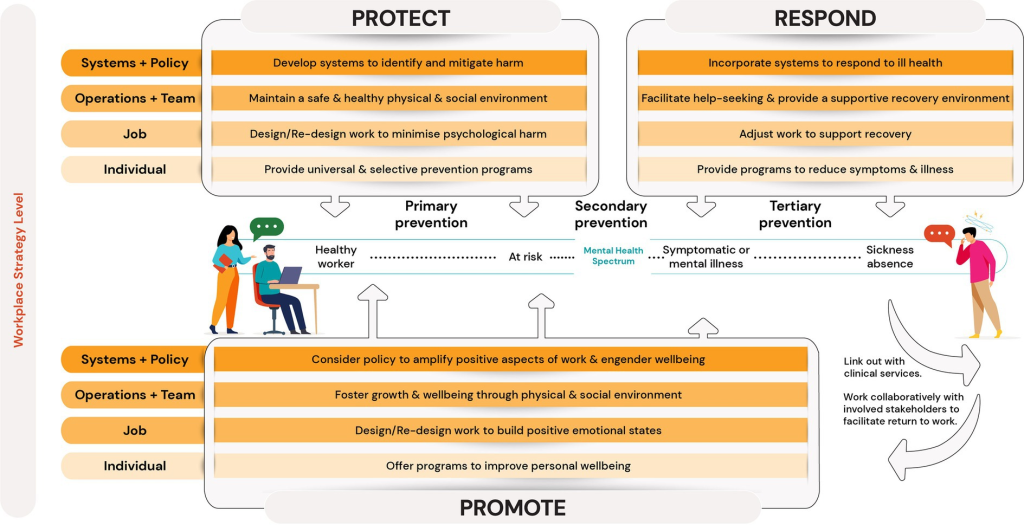
To Build a Mentally Healthy Workplace
In recent years, mental health in the workplace has become a critical public health issue. From high-pressure jobs to the increasing demands of modern work life, employees face a range of challenges that can impact their mental well-being. The repercussions are not just personal; they extend to businesses through decreased productivity, higher absenteeism, and increased healthcare costs. Addressing mental health at work is both a social and financial imperative.
The Invisible Hazards: Psychosocial Risks
Workplace mental health isn’t just about preventing obvious physical dangers like faulty machinery or hazardous materials. There are less visible but equally harmful factors known as psychosocial risks. These include high job demands, lack of role clarity, low job control, and poor interpersonal relationships at work. For example, a high workload or long hours can lead to stress and burnout, while unclear job roles can cause anxiety and confusion.
Psychosocial risks also encompass the organizational culture, including how employees are recognized and the stability of their jobs. A supportive and fair workplace culture can significantly mitigate these risks. Conversely, environments where bullying or harassment are present can exacerbate mental health problems.
Updating the Framework for Mentally Healthy Workplaces
Recognizing the evolving understanding of workplace mental health, a new framework has been developed to help employers create healthier work environments. This updated Framework for Mentally Healthy Workplaces integrates recent research and best practices, providing a comprehensive guide for organizations to enhance employee well-being, minimize harm, and facilitate recovery.
The framework is built on three main pillars: Protect, Respond, and Promote. Each pillar addresses different aspects of workplace mental health and offers strategies tailored to various levels within an organization, from individual employees to overarching systems and policies.
Protect: Preventing Harm
The first pillar, Protect, focuses on preventing mental health issues before they arise. This involves identifying and managing psychosocial hazards through comprehensive risk assessments. For instance, implementing flexible work policies can reduce stress by allowing employees to balance their work and personal lives more effectively. Improving communication and increasing job control can also mitigate risks associated with high job demands and unclear roles.
Respond: Addressing Mental Health Issues
When mental health issues do occur, the Respond pillar provides strategies for addressing them promptly and effectively. Early intervention is crucial. This can include mental health training for managers to help them recognize signs of distress and provide support. Mental Health First Aid (MHFA) training equips employees with the skills to assist colleagues in crisis, fostering a supportive workplace environment.
Promote: Enhancing Well-being
The Promote pillar goes beyond merely preventing harm to actively enhancing well-being. This involves creating a work environment that not only minimizes risks but also promotes positive mental health. Initiatives can range from mindfulness and stress management programs to fostering a culture of recognition and support. Encouraging social connections and providing opportunities for personal growth and development are key components of this pillar.

The Four Levels of Intervention
To effectively implement these strategies, the framework outlines four levels of intervention:
- Systems and Policy Level: This includes creating organizational policies that prioritize mental health, such as flexible working arrangements and anti-bullying policies. These systems should reflect the cultural values of the organization and promote a psychologically safe environment.
- Operational and Team Level: Initiatives at this level aim to improve the interpersonal and physical environment. For example, team-building activities can enhance social connections, while ergonomic adjustments can improve physical comfort.
- Job Level: Job design plays a critical role in mental health. Strategies here include ensuring job roles are clear and manageable and provide employees with a degree of control and autonomy.
- Individual Level: Programs targeting individual employees focus on building resilience and coping skills. This can include mindfulness training, cognitive-behavioral therapy (CBT) programs, and physical activity initiatives.
Overcoming Challenges
Despite the clear benefits, implementing these strategies can be challenging. Organizations often face barriers such as limited resources, lack of awareness, and resistance to change. However, the updated framework provides a roadmap for overcoming these obstacles. By taking a systematic and coordinated approach, employers can create environments where employees thrive.
Why It Matters
Investing in workplace mental health is not just a moral obligation; it’s a smart business strategy. Healthier employees are more productive, engaged, and loyal. They take fewer sick days and are less likely to leave their jobs. For public health practitioners and researchers, understanding and promoting these practices is essential for creating healthier communities and reducing the burden on healthcare systems.
Join the Conversation
- What mental health initiatives have you seen or implemented in your workplace? Share your experiences and let us know what worked or what didn’t.
- How do you think organizations can better support employee mental health? Join the conversation and provide your insights or suggestions.
Empower Your Network – Subscribe and Share!
Unlock key insights with ‘This Week in Public Health.’ Subscribe for free and share to drive change as part of a dedicated community.



